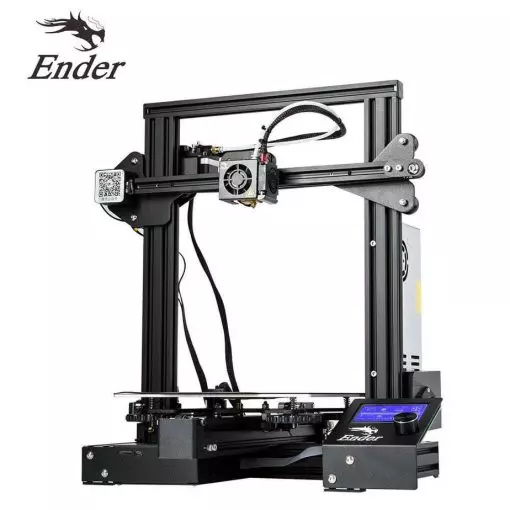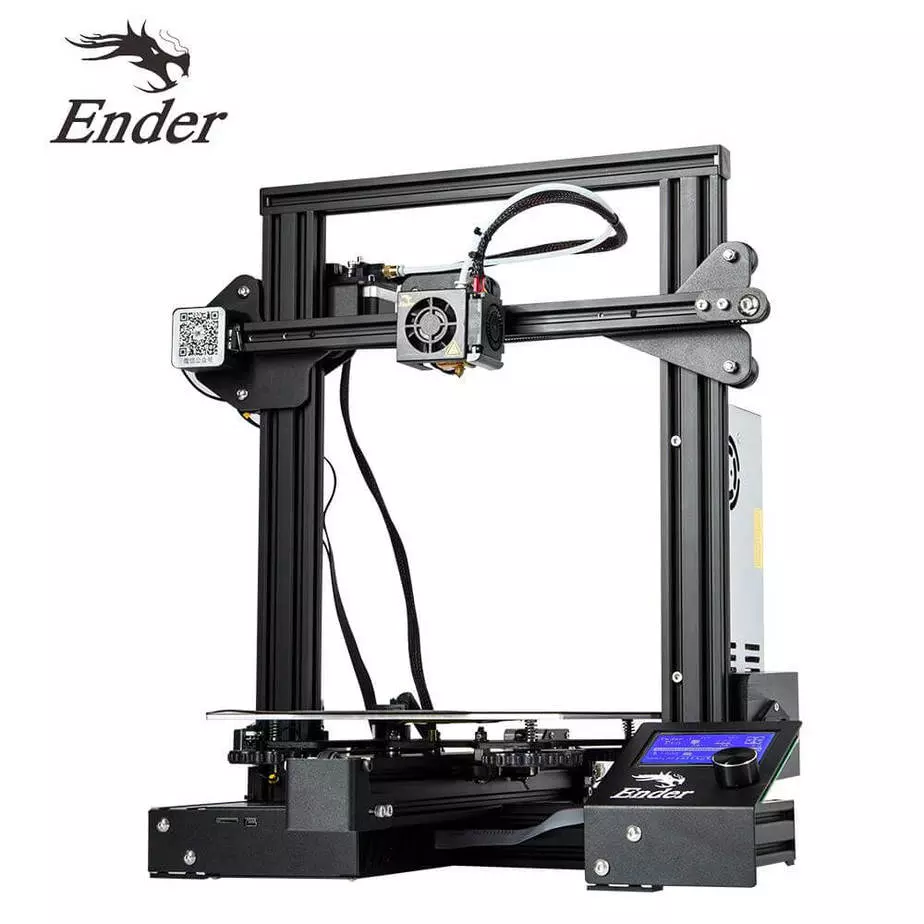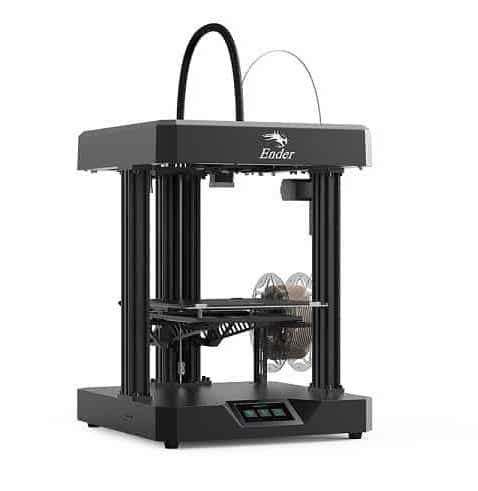Compare Ender 3 vs Ender 3 PRO vs Ender 7
Comparison between the best 3D printers
Choose the best 3D printer at the best price. The cheapest 3D printers are here.
Buy a 3D printer here with 3D Fila.
 |
 |
 |
|
| Model | Ender 3[BUY Ender 3] |
Ender 3 PRO[BUY Ender 3 PRO] |
Ender 7[BUY Ender 7] |
| Estimated price | $210,00 | $258,00 | $429,00 |
| Fabricante | Creality 3D | Creality 3D | Creality 3D |
| Release Year | 2018 | 2019 | 2021 |
| Print Volume [mm] | 220x220x250 | 220x220x250 | 250x250x300 |
| Printer Size [mm] | 440x440x465 | 440x440x465 | 430x460x570 |
| Weight [kg] | 6,62 | 6,62 | 17,2 |
| Power Loss Recovery | NO | NO | YES |
| Enclosed printer | NO | NO | NO |
| Bed Leveling | Manual | Manual | Manual |
| Filament End Sensor | NO | NO | YES |
| Bed type | Heated | Heated | Heated |
| Power supply system | Bowden | Bowden | Bowden |
| Standard nozzle | 0,4 | 0,4 | 0,4 |
| Maximum Nozzle Temperature [°C] | 255 | 255 | 260 |
| Maximum Bed Temperature [°C] | 110 | 110 | 100 |
| Maximum printing speed [mm/s] | 180 | 180 | 250 |
| Filament holder | YES | YES | YES |
| Camera for supervision | NO | NO | NO |
| Recommended filaments | PLA, TPU, ABS, PETG | PLA, TPU, ABS, PETG | PLA, PETG, Tritan, Flex, ABS |
| Recommended slicers | Cura, Simplify, Slic3r | Cura, Simplify, Slic3r | Cura, Simplify, Slic3r, IdeaMaker |
| Maximum Resolution [mm] | 0,1 | 0,1 | 0,1 |
| Processor | 8 bits | 32 bits | Creality CR-FDM V.2.4.S1_V101 32bits |
| Display | Mono | Mono | Display touchscreen 4,3'' |
| Power Supply | 24V / 270W | 24V / 360W Meanwell | 110/220V / 350W |
| Connectivity | SD / USB | SD / USB | SD / USB |
| Operating systems | Windows, Mac, Linux | Windows, Mac, Linux | Windows, Mac, Linux |
| Date of registration in the system | 2021-04-13 | 2021-04-14 | 2022-11-04 |
| Release date | 2018 | 2019 | 2021 |
| Extra features | The Ender 3 V1 is a DIY assembly 3D printer, a sales leader since 2017, standing out for its cost-benefit. With a wide printing capacity, it has a CNC machined structure for precision and stability. It offers high-precision prints with low noise, thanks to its innovative V-profile and pulleys. It has a self-adhesive magnetic platform for easy removal of models and excellent adhesion. The Ender 3 heats up quickly, reaching 100°C in 5 minutes, ideal for agile prints. It includes protection against power failures, allowing you to resume printing after interruptions, saving time and material. | The Ender 3 Pro stands out for its beginner-friendly assembly and easily modifiable structure. With a 350W power supply, it heats up quickly and has a simple application that offers good print quality. However, its motors and fans are noisy, and the interface seems outdated. Assembly is accessible, without the need for advanced techniques, and it has integrated belt tensioners. It includes a detailed guide and supports microSD card and USB. | Crealitys Ender 7 printer offers remarkable print speeds, utilizing CoreXY kinematics for precise and fast movement. With a 250x250x300mm build area, dual direct extruder, and custom hotend, the Ender 7 is capable of printing at high speeds, although quality may suffer on smaller prints. Assembly is relatively straightforward, but the machine is noisy and can get hot. Its true speed potential is most noticeable on larger prints, where it outperforms its competitors. |
| Support for multiple colors and materials (AMS and CFS) | NO | NO | NO |
Notes * |
|||
| Cost-benefit | 6 / 10 | 6 / 10 | 7 / 10 |
| Hardware | 0.5 / 10 | 0.5 / 10 | 2.4 / 10 |
| Screen | . | . | . |
| Print volume | 3 / 10 | 3 / 10 | 4 / 10 |
| Performance | 1 / 10 | 1 / 10 | 2 / 10 |
| [BUY Ender 3] | [BUY Ender 3 PRO] | [BUY Ender 7] |
Conclusion |
| In comparing the three Creality 3D printers—Ender 3, Ender 3 Pro, and Ender 7—each model presents unique advantages and pricing considerations that cater to different user needs. The Ender 3 is the most budget-friendly option, offering a solid entry point for beginners. Its reliable performance, decent print volume, and good build quality make it a prominent choice for hobbyists and those new to 3D printing. However, it lacks advanced features such as power loss recovery and a filament end sensor, which may be relevant for more dedicated users. The Ender 3 Pro builds on the foundation of the Ender 3 with slight enhancements, including a more substantial power supply for quicker heating and modifiable structure. While its print quality remains commendable, potential noise from its motors could be a consideration for users seeking a quieter operation. It remains a sensible choice for entry-level users who want a bit more flexibility without a significant increase in cost. The Ender 7, though significantly pricier, is designed for users prioritizing speed and efficiency. With a larger build volume and improved print speeds—achieved through CoreXY mechanics—the Ender 7 excels in producing larger prints quickly. However, users should be aware that the increased speed could sometimes compromise print quality on smaller models. Additionally, it includes features such as a dual-extruder setup and a more advanced touchscreen interface, appealing to those who are more serious about their 3D printing endeavors. In conclusion, if budget is a key factor and you're new to 3D printing, the Ender 3 or Ender 3 Pro would be well-suited choices. For more advanced users who prioritize speed and larger print volumes, the Ender 7 stands out as a superior but more expensive option. Evaluating your specific needs in terms of budget, print scale, and desired features will help in making the best decision among these three options. |

